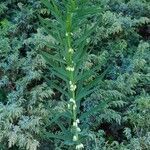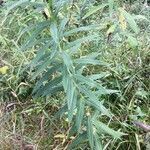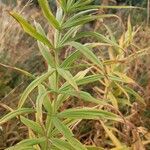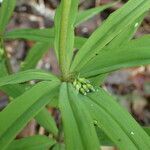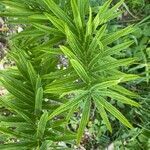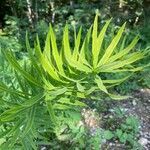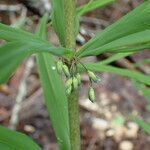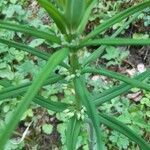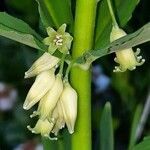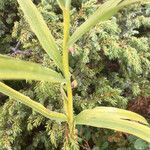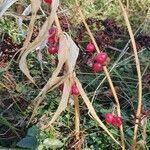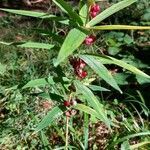Rhizome usually shortly branched, usually tuberous terete, very rarely moniliform, 0.7--1.5 cm thick. Stem erect, (20--)40--80 cm, glabrous. Leaves in whorls of 3, occasionally alternate near base of stem, sometimes opposite near apex of stem, subsessile, oblong-lanceolate to linear, 6--10 × 0.5--3 cm, apex acute to acuminate, not cirrose. Inflorescences 1-or 2(--4)-flowered; peduncle 1--2 cm; bracts small or absent. Flowers pendulous; pedicel 3--10 mm. Perianth pale purple (or white or pale yellow, but probably only when dry), cylindric, 0.8--1.2 cm; lobes 2--3 mm. Filaments 0.5--1(--2) mm, papillose; anthers ca. 2.5 mm. Ovary ca. 3 mm. Style 2.5--3 mm. Berries red, 6--9 mm in diam., 6--12-seeded. Fl. May--Jun, fr. Aug--Oct. 2 n = (24), 28, 30, (56*), 60, (64, 66, 84), ca. 90.
More
A herb. It grows to 1 m high. It has a rhizome or underground stem. This is 0.7-1.5 cm thick. The stem is angled and grooved. The leaves do not have stalks. They occur as 3-8 in rings. The leaf blade is 6-10 cm long by 0.5-3 cm wide. They are narrow and sword shaped. There are hairs along the edge. The edges are slightly rolled in. They taper to the tip. The flowers are white. They occur as two together on stalks in the axils of leaves. The flowers hang down. The fruit are berries. They are red and 6-9 mm across. There are 6-12 seeds.
Margins of woods, clearings and shady rocky places, usually on acid soils. Forests, grassy slopes; at elevations from 2,100-4,000 metres.
More
It is a temperate plant. In Nepal they grow between 2000-4000 m altitude.
